GO Fas Bitst NEWS
Author: stathi Date Posted:26 July 2022
How to Choose Wastegate Springs
In this article we’ll take a look at wastegate springs, and how the correct spring selection can improve performance.
The good news is that selecting the right wastegate spring is a relatively simple and cost-effective way to ensure the best possible spool up and boost stability, with minimal high-RPM boost drop-off, so let’s get to it!
First, a word of caution – when changing wastegate springs you MUST re-adjust your boost control settings afterwards. If you have a manual or electronic boost controller this is easy to do, but if boost is controlled by your ECU and you don’t have access to change it, you should consult your tuner before going any further.
In this article we’ll be concentrating on turbo systems with either an internal or external pneumatic wastegate, connected to a boost control system that uses boost pressure to actuate the wastegate. Other systems such as VNT, vacuum or electric actuators, and C02 boost control systems fall outside the scope of this discussion.
We’ll be using the term “gate pressure” to refer to the boost pressure your turbo system achieves with no input from the boost controller. Gate pressure is directly influenced by the wastegate spring.
Please note however that whilst wastegate springs typically have a boost pressure “rating”, this is a guideline only. It is impossible to predict the exact gate pressure a certain spring will achieve due to the vast number of variables involved in the turbo and wastegate system, but the spring should deliver a gate pressure that is pretty close to its advertised “rating”.
Boost Controller “Rule of Thumb”
Boost pressure should be no more than double your wastegate’s “gate pressure”.
You may have come across this rule of thumb before, but understanding where it comes from will help greatly when it comes to wastegate spring selection.
A pneumatic wastegate is a self-regulating, closed-loop control system, which uses a boost reference signal as a feedback loop. As boost pressure rises, the boost reference to the wastegate diaphragm causes the valve to open more, which prevents further boost increase. If boost drops, the valve will open less to prevent boost dropping further. The spring in the wastegate determines the “equilibrium” point, where all the forces are balanced and boost is stable. This is how “gate pressure” is achieved and regulated by the wastegate.
A boost controller works by bleeding a controlled amount of pressure from the wastegate’s boost reference hose, thereby raising the boost pressure at which “equilibrium” is achieved. The more you bleed off, the higher the boost pressure goes.
But there’s a limit – once you’ve bled off most (or all) of the boost reference signal, there’s nothing left to control the wastegate – the feedback loop is gone, or at least seriously compromised.
This limit occurs sooner than you’d think. For example, it is not uncommon for a small factory turbo with a gate pressure of 7psi to make around 12-13psi stock, which fits within the “rule of thumb”. However, turn the boost up to 16psi and you’re at more than double the gate pressure, and the boost reference signal to the wastegate would be no more than 2-3psi.
Remember that the wastegate uses this reference signal to regulate boost pressure and compensate for variations. But since the reference signal has been slashed from 16psi to 2-3psi, the boost controller’s “authority” over the wastage is significantly diminished, and variations in boost pressure cannot be effectively corrected to maintain stable boost.
Push this same turbo to 18psi and the boost controller is now just a passenger!
Once the boost pressure is more than double the gate pressure, external variables that typically affect the turbo’s ability to make boost (i.e. atmospheric temperature/pressure, engine RPM and load, exhaust backpressure etc) cannot be effectively corrected for and boost control becomes less stable. Spool up will not be as aggressive (since the wastegate will be blown open by the exhaust pressure), peak boost may differ from one day to the next, and boost will likely drop off significantly at high RPM.
Selecting a Wastegate Spring for Best Performance
You can see from the examples above that the more your target boost and gate pressure differ, the more your performance suffers.
Whilst keeping the boost to no more than double the gate pressure offers acceptable boost control, better performance can be achieved by selecting a wastegate spring that gives a gate pressure 10-20% lower than your target boost. This ensures your wastegate and boost controller have a strong boost reference signal to work with to make corrections, which results in the best possible spool up and boost stability, with the least boost drop off at high RPM.
Multiple Boost Settings
But what if you plan to use multiple or variable boost settings? You might map your ECU to deliver lower boost at part throttle or in low gears, or you might want to set a boost controller to deliver low or high boost settings depending on road/track conditions.
In this case it is best to select a wastegate spring that achieves your lowest boost setting (i.e. your low boost setting = gate pressure), and ensure your highest boost setting is no more than double the lowest setting.
If this is not possible, a compromise will need to be determined. Either the low boost setting remains where it is, and the high boost setting will not be optimised for performance, or the low boost setting is increased with a stiffer wastegate spring, and the high boost setting is given the best possible performance.
Conclusion
Selecting the right spring for your wastegate is a simple way to ensure you get the best possible performance from your turbo!
GFB WGA – HIGH PERFORMANCE INTERNAL WASTE GATE ACTUATOR
THE WGA IS A HIGH PERFORMANCE INTERNAL WASTEGATE ACTUATOR DESIGNED TO IMPROVE BOOST CONTROL ON TURBO SYSTEMS WITH AN INTERNAL WASTEGATE.
When diving into the world of increasing your car’s boost pressure, the limits of a factory-fitted wastegate actuator can soon become apparent. Even with electronic boost control it is not always possible to overcome wastegate issues such as boost drop off at high RPM, unstable boost curve, or an inability to achieve target boost.
Upgrading to a GFB WGA ensures you get the best possible performance and response from your turbocharger!
WGA BENEFITS
(COMPARED TO A FACTORY-FITTED ACTUATOR):
- Faster spool up
- Less boost taper at high RPM
- More stable boost control
- Customizable spring rates
- Supports higher boost pressure
It’s what we like to do here at GFB – maximize performance and minimize size.
Here’s how we did it with the WGA:
- Industry-first diaphragm design – the WGA’s Nomex-reinforced silicone diaphragm is designed to achieve the largest effective diaphragm area with the smallest possible outside diameter. This gives the WGA more control authority over the wastegate flap, resulting in better boost control. It’s a bit like being the turbo’s puppet-master, rather than its puppet!
- No unnecessary bulk sounds obvious, but attention to detail in the design means the WGA is the shortest actuator on the market.
- Longest stroke – with 18mm of rod travel, the WGA is suitable for controlling the largest of internal wastegates, or the extra travel can be used to further increase boost pressure without having to change springs.
- Unique pivoting rod guide – machined from PEEK (an extremely high-performance engineering polymer), the encapsulated spherical rod guide takes up significantly less height in the actuator body than other designs, whilst offering low friction and superior wear resistance.
MORE ADJUSTABLE, MORE EASILY.
Setting the base spring pressure correctly for your application can have significant performance benefits, so we made sure the WGA offers the best adjustability on the market!
We supply 3 stainless steel springs that can be used in any combination ranging from 5psi to 22psi, but that’s only the beginning. Whilst other brands may offer more spring options (sold separately), changing springs to fine-tune boost pressure is time consuming and quite frankly, a pain in the butt.
That’s why we added another industry-first: turnbuckle adjustment. Because the WGA was designed with a long stroke, it is possible to use some of that extra stroke length to fine-tune the base boost pressure in a matter of minutes without swapping
springs or removing the actuator.
As an added benefit, the turnbuckle makes swapping springs so easy that it can often be done without removing the actuator from the car!
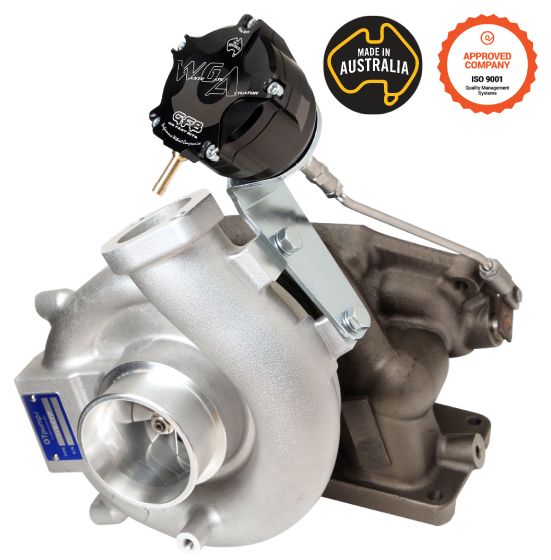
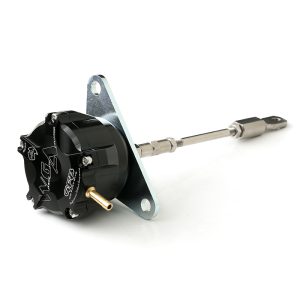
PART NO: 7300
WGA Wastegate Actuator – Lancer Ralliart
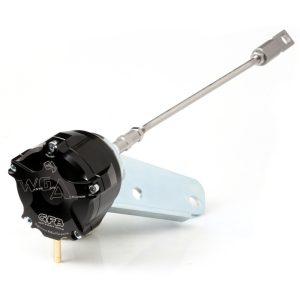
PART NO: 7301
WGA Wastegate Actuator EVO 4-8
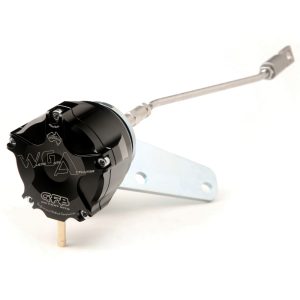
PART NO: 7302
WGA Wastegate Actuator EVO 9

PART NO: 7303
WGA Wastegate Actuator EVO X
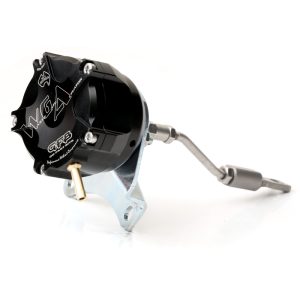
PART NO: 7304
WGA Wastegate Actuator WRX
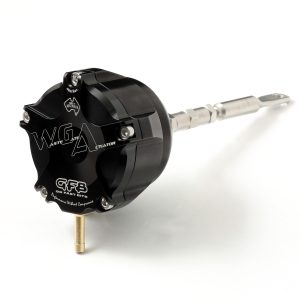
PART NO: 7306
WGA Wastegate Actuator XR6











